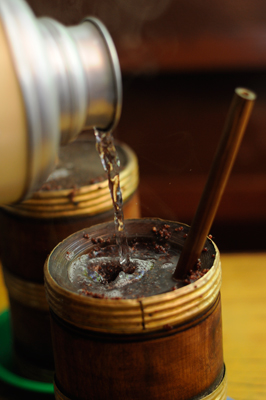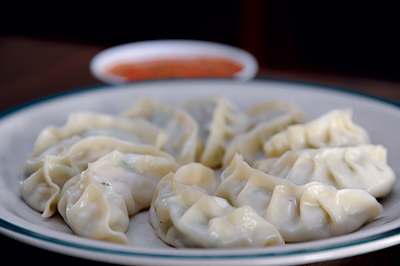Nothing like some great food and drink to get a Nepali in a good mood.
The coldest winter in a decade is upon us. Blankets have been pulled out ready for the colder nights. Everyone is finding excuses to stay under their covers for that extra 10, 20 minutes wbefore they have to go about their day. With the dark cold nights, the thing to do is to gather around fires and then sneak off to bed earlier. Yes, Nepal is going into hibernation.
 To battle the harshness of the cold, most Nepalis turn to a favourite comfort: food. Dal bhat (rice and lentil soup) - which famously provides 24 hours of power, like it says on the country’s trekking route teahouses - is eaten throughout the year. What would Nepal do without having a good plate of rice at the end of a long day’s work come monsoon or winter? But although dal bhat is still very much the staple, to mark the winter months, kitchens in Nepal start steaming up with all sorts of concoctions to keep the cold at bay. Additionally, strawberries, oranges and pomegranates ripen in gardens. Radish pickles sit bottled on sunny window sills. Millet seeds ferments over time, its aroma wafting through doorways and people look forward to pouring some more hot water into their Tongba. Glasses of steaming milk tea are topped up, repeatedly, as people huddle around small fires.
To battle the harshness of the cold, most Nepalis turn to a favourite comfort: food. Dal bhat (rice and lentil soup) - which famously provides 24 hours of power, like it says on the country’s trekking route teahouses - is eaten throughout the year. What would Nepal do without having a good plate of rice at the end of a long day’s work come monsoon or winter? But although dal bhat is still very much the staple, to mark the winter months, kitchens in Nepal start steaming up with all sorts of concoctions to keep the cold at bay. Additionally, strawberries, oranges and pomegranates ripen in gardens. Radish pickles sit bottled on sunny window sills. Millet seeds ferments over time, its aroma wafting through doorways and people look forward to pouring some more hot water into their Tongba. Glasses of steaming milk tea are topped up, repeatedly, as people huddle around small fires.
So here’s the silver lining on the grey clouds, some of the more popular local recipes which gladden the heart, fill the stomach and warm the hands when you need it the most.
Mula ko achaar
A spicy mix to have with dal bhat or beaten rice
Ingredients
Radish
Salt
Mustard seed
Mustard oil
Turmeric
Green chilli pepper
How to make it
Chop up the radish into sticks and leave it to dry in the sun for a day. While the radish is drying, cut up the green chilli and place it in the sun for a few hours. How spicy you want your Achar will depend how much chilli you use. Now, grind some mustard seed to make powder. Mix some turmeric and salt in mustard oil. Heating up the oil, add the dried radish and capsicum; adding the turmeric, mustard seed and salt according to taste. The Achar can then be bottled and will be ready to eat 3 to 4 days later. If you dry the radish for a longer period of time, say 2 days, you will need to add more oil.
Bhogate sadeko
A mid afternoon snack to sit and enjoy in the sunshine
Ingredients
Pomelo
Oranges
Sesame seed
Yoghurt
Turmeric powder
Chilli powder
Mustard oil
Funugreek
How to make it
Put the chopped pomelo and oranges in a bowl together. Mix them and add some sesame seed, chilli powder, yoghurt and turmeric. Next heat up the mustard oil. Once the oil is hot, fry the fenugreek. Once the fenugreek turns black add it to the pomelo mix.
Masala Chiya
Spiced Nepali milk tea to warm up cold mornings (who are we kidding; the entire day!)
Ingredients
Chiya granules
Water
Black pepper
Sugar
Cardamom
Ginger powder
Milk
How to make it
For four people, boil up two mugs worth of water and two mugs of milk. Some people like their chiya sweet, some not, so add sugar accordingly. Add about half a teaspoon of ground black pepper and ginger powder to the heating pan. Then throw in about six open cardamom pods. As the mixture starts to simmer, add a tablespoon of chiya. Stir everthing together as it boils and use a sieve to filter out the tea. If you don’t fancy a milk chiya, supplement the ginger power with freshly crushed ginger and only add about 1 teaspoon of the chiya granules to the pan.
 Tongba:
Tongba:
A hot Tibetian alcoholic drink
Ingredients
Millet (whole grain)
Murcha: a source of moulds, bacteria and yeast.
How to make it
Firstly, cook the millet seed. Once it is cooked leave it to cool and mix it with murcha. Next place the mixture in a container and cover it with a thick cloth. Leave it in a warm place for 1 to 2 days. (This is dependant on air temperature.) The mass should then be packed into air tight plastic jars. Again, depending on air temperature, leave it for 7 to 15 days. The fermentation completed, the Jaand should now be left to mature. Traditionally the Jaand is stored up to around 6 months. To drink the Jaand in the traditional way the fermented millet is placed in a wooden pint-like jug called Tongba. Boiled water is poured into the pint and it is left to sit for 5 minutes. The water is infused with the alcohol and is drunk through a bamboo straw. The bottom end of the straw is sealed to prevent the millet seed from seeping up but the straw is perforated to allow the alcohol through. The jug is topped up regularly with hot water until the alcohol is finished.
Thukpa
Steaming hot Tibetan style soup enjoyed during the winter
Ingredients
4 Eggs
Flour (the more flour the thicker the soup)
1/2 Kg meat, (Pork is preferred but any meat will do) cut into very thin 1/8 inch slices
1/2 cup carrots, thinly sliced
1 cup spinach, washed and cut into pieces
1 cup onions, chopped
1 Tbsp garlic, minced
1 Tbsp ginger, minced
1/2 tsp turmeric
3 fresh chilli peppers sliced
2 Tbsp cooking oil
salt and pepper to taste
1 Tbsp chopped coriander (to garnish)
How to make it
Boil the noodles in salted water until they are slightly undercooked. Drain and rinse them. In a sauce pan, heat two tablespoons of cooking oil. Add the onions and fry them until they are light brown. Add the turmeric, garlic, ginger and chillies to the onion. Adding the meat, brown it well. Next add the flour, water, salt and pepper and cook until the meat is tender. Put the carrots and spinach shreds to the soup and cook for a couple of minutes until the vegetables are soft. Having fried up the eggs separately add them as well and season according to taste. Serve the soup up immediately and garnish with coriander.
 Mo:mo:
Mo:mo:
The closest alternative to the Nepali staple of dal bhat
Ingredients
Flour
Onions/onion leaves
Salt
Ginger paste/juice
Soya sauce
Coriander leaves
Jeera
Chilly powder
Tomatoes
Cheese
Red chillies
Peanuts
How to make it
To prepare the meat that goes into the mo:mo:, mix minced buff meat, chopped onion or onion leaves, ginger paste (or juice), salt (to taste), soya sauce, coriander leaves (chopped or grounded), jeera, chilly powder and smoked or boiled tomatoes. If possible use your hands to mix it well so that the flavors of the spices used really gets into the meat. Leave for a few hours.
For the outside bread of the mo:mo:, mix water and flour to prepare a dough and roll fist sized balls of it. Flatten the balls into plate sized circles and use the mouth of a steel glass to cut out smaller circles. There are numerous dips people enjoy with their mo:mos.The simplest one is made by boiling or pan frying tomatoes, grinding them on a grinding stone along with finely chopped coriander and salt and green chillies to taste.
Put tablespoonfuls of the meat onto the flour cutouts and fold using a technique that closes the mo:mos off beautifully. Use own techniques for starters. Oil the base of the mo:mo making container with holes on the bottom so the flour doesn’t stick to it. Allow the steam from the boiling water in the bottom container to cook the mo:mos.











